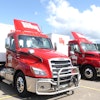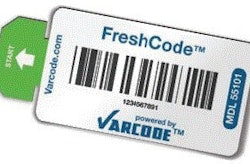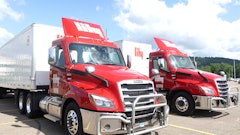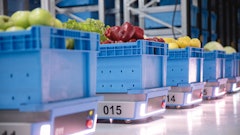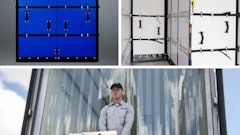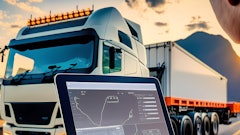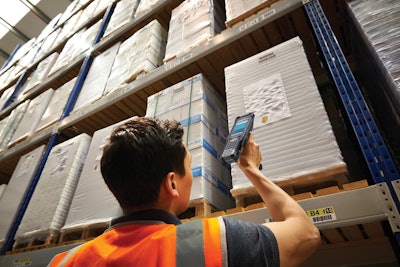
The introduction of digital marketplaces and a booming e-commerce sector has placed a strain on the entire supply chain. Transportation costs are high, capacity is tight and customer expectations are higher than ever, requiring faster and more agile operations.
To fulfill this increasing consumer demand for immediate access to goods and services, companies are re-evaluating each process in their supply chain and introducing emerging technologies where applicable.
A new study, Future of Field Operations, by Zebra Technologies Corp., reveals that mobile technology investment is a top priority for 36 percent of organizations and a growing priority for an additional 58 percent to keep up with rapidly evolving and increasing customer demand. The findings indicate a majority of investments in mobile enterprise devices will be made to enhance front-line worker productivity and customer satisfaction in field operations, including fleet management, field services, proof of delivery and direct store delivery workflows.
Read Next: 5 Key Questions to Shape a Successful Blockchain Initiative
“Driven by the acceleration of e-commerce along with customers’ heightened expectations and more focus within companies on differentiating service levels, the field operations industry is rapidly adapting the way it looks at its mobile technology investments,” says Jim Hilton, director of vertical marketing strategy, manufacturing, transportation and logistics for Zebra Technologies. “Our study shows how growing challenges related to the on-demand economy drive organizations to adopt transformative, disruptive technologies such as augmented reality and intelligent labels to provide visibility and integrate business intelligence for a performance edge.”
Mobile Devices as a Competitive Advantage
Two of the biggest e-commerce trends driving mobile adoption are challenges in last-mile delivery and expanding fulfillment options, says Mark Wheeler, director of supply chain solutions for Zebra Technologies.
“We’re all at the point where we expect to have visibility into that delivery process and confirmation of that delivery process, and where appropriate, signature capture at the point of delivery,” he explains. “We’re going to be tracking those materials through that process—from the sortation hub to loading on the vehicle to delivering at the end customer—so data capturing ability to scan a variety of different barcodes is increasingly part of that solution on the e-commerce side.”
 Zebra Technologies
Zebra Technologies
E-commerce fulfillment from either the retail store or from a regional or urban distribution center (DC) is also growing, promising increasingly rapid order turnaround times. In order to provide real-time and error proof data capture and scanning, Wheeler says retailers need to be mobile.
As these e-commerce trends grow, equipping front-line workers with enterprise mobile devices remains a priority to stay competitive, though only one-fifth of organizations have a majority of their field-based operations using enterprise mobile devices, according to the study. The study estimates companies will reach 50 percent adoption in five years, driven by higher levels of inventory and the need for more accurate shipments and asset counts.
Respondents indicate most organizations intend to invest in handheld mobile computers, mobile printers and rugged tablets. From 2018 to 2023, handheld mobile computer usage with built-in barcode scanners is forecasted to grow by 45 percent, mobile printers by 53 percent and rugged tablets by 54 percent.
Read Next: Why Your Rival’s E-Commerce Setup Might Not Be as Perfect as You Think
Greater e-commerce connectivity at the consumer level is also driving enterprise mobility adoption. Not only is it now easier to order goods and services, but online reviews and social media allow consumers to hold service providers to higher standards. The study found that 90 percent of consumers read online reviews before visiting a business, 88 percent trust online reviews as much as personal recommendations, and 86 percent hesitate to purchase from a business that has negative online reviews.
In addition, whether its business-to-consumer or business-to-business, consumers expect the convenience of ordering service calls and deliveries online and can track shipments while in progress. The authors of the study claim that mobile technology enables field teams to solve these challenges.
“Teams can review equipment repair histories before leaving on their routes and quickly access online documents, specifications and parts inventories or order parts deliveries if they encounter problems later,” the study says.
Mobile technology, the authors say, also enables field teams to process mobile payments for customer convenience and shorter cash-flow cycles.
In addition, advances in machine learning-based software applications that collect data from sensors will provide teams with data-driven indications of required equipment maintenance or merchandise replenishment so they can proactively set appointments.
“Data-driven, mobilized field operations offer beneficial workflow disruptions like these that can raise service to match or even exceed customers’ growing expectations,” the study’s authors note.
The large screens and ruggedized design of business tablets also make it easy to read detailed equipment schematics, delivery orders or task checklists, and keep workflows moving in a wide range of environmental work conditions.
Total Cost of Ownership Still a Concern
Tertiary concerns and post-sale factors are important for organizations when evaluating front-line worker enterprise mobile devices. Nearly 80 percent of respondents usually or always conduct a total cost of ownership (TCO) analysis of business devices prior to making a capital expenditure, and only 32 percent believe that consumer smartphones have better TCO than rugged devices.
“There’s pretty broad acceptance in the market that enterprise devices have a lower total cost of ownership. But we also see that the most prominent decision in the investment tends to be those upfront costs, the initial acquisition—even though they understand that over the long run, it’s going to be more expensive,” notes Wheeler. “The key is to have the customer focus on what’s the real cost, the real value of choosing A versus B?”
The survey reveals the following TCO considerations when investing in new front-line enterprise technology: replacement (47 percent), initial device (44 percent), application development (44 percent) and programming/IT (40 percent).
Almost 40 percent of respondents say device management and support costs are important in addition to customer service (37 percent), device life cycle cadence (36 percent) and repair costs (35 percent). Such factors increasingly influence the purchase cycle, showing that those who do not provide clear value or cannot control these costs will quickly be overtaken by those who do.
“It’s really just educating the customer on what the implications of these decisions are—both on the operation side for the end user and on the IT side from a management perspective. And if we can help the customer understand all of that, it’s a win-win,” adds Wheeler.
Read Next: Behind the Hidden Complexity of E-Commerce Fulfillment
Emerging Technologies & Faster Networks
Emerging technologies and faster networks are disrupting field operations. The survey shows seven in 10 organizations agree faster mobile networks will be a key driver for field operations investment to enable the use of disruptive technology.
Significant industry game-changers will be droids and drones, with over a third of decision-makers citing them as the biggest disruptors.
The use of smart technologies such as sensors, RFID and intelligent labels also play a role in transforming the industry. More than a quarter of respondents continue to view augmented/virtual reality (29 percent), sensors (28 percent), RFID and intelligent labels (28 percent) as well as truck loading automation (28 percent) as disruptive factors.
“Giving assets throughout the supply chain a digital voice is something that we’ll see across the board,” adds Wheeler. “Interest in RFID, intelligent labels, sensors of different types throughout the supply chain is increasing visibility and accuracy of the delivery process.”


